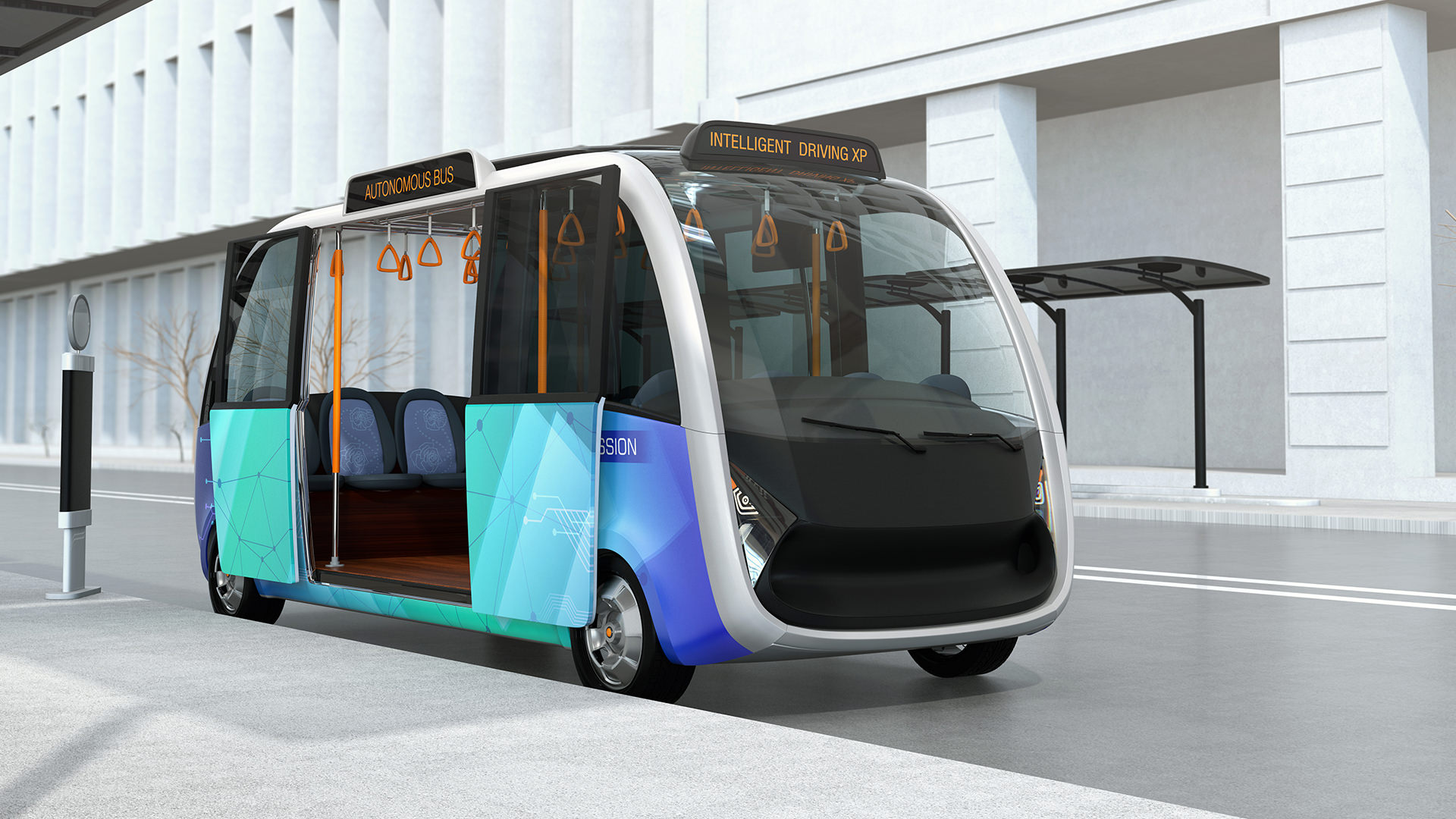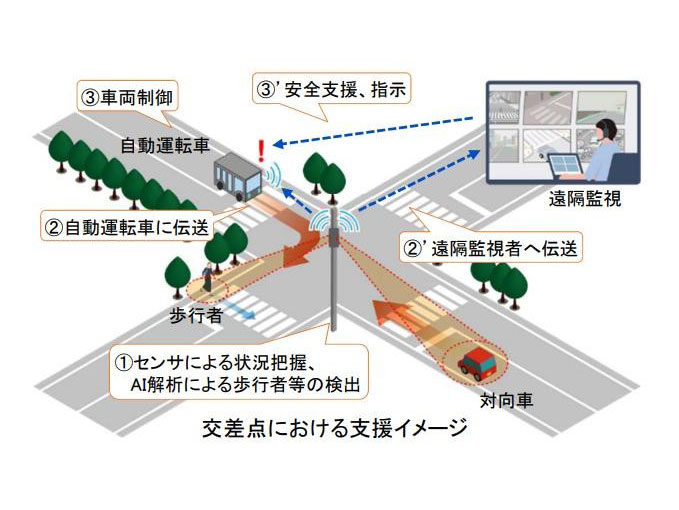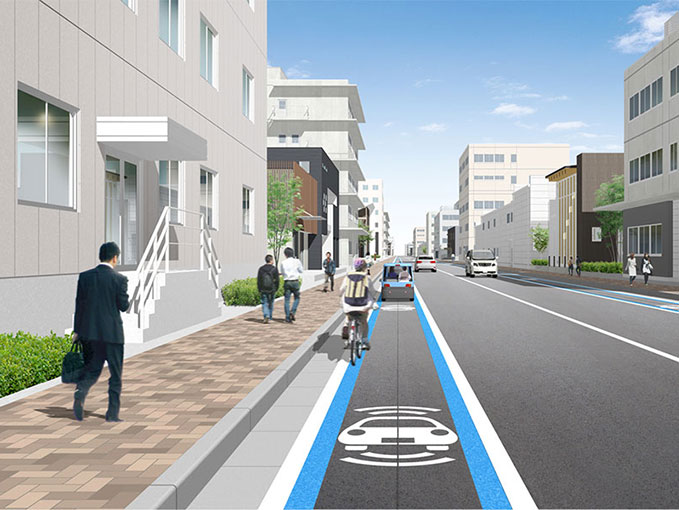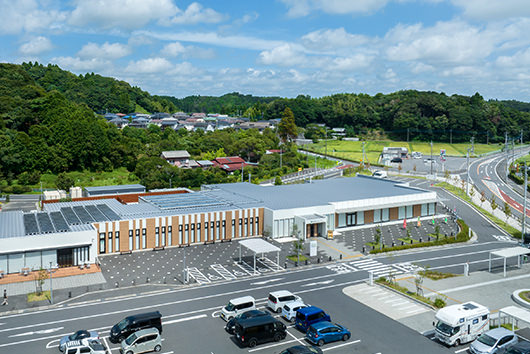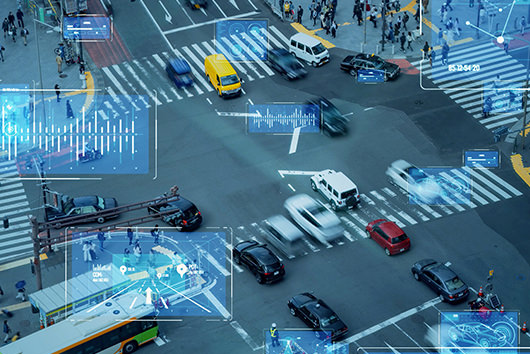Route buses are essential public transportation that anyone can use easily. However, an increasing number of routes are being forced to reduce or discontinue service due to decreasing users and a lack of drivers, making stable continuity a major issue. This is where expectations are rising for autonomous driving buses. While a field demonstration experiment and demonstration runs are underway across the country, challenges are also emerging. We interviewed three people who have been involved in the development of autonomous driving systems and supporting the introduction of autonomous driving buses for a long time, including Akira MITSUYASU and Kai KOMORI from the Mobility DX Sec., DX Business Promotion Dept., and Ken WATANABE from Urban Management Sec., Transportation Planning Dept., about the current state of the introduction of autonomous driving buses, the steps involved, and points to be aware of.
INDEX
- Facing issues about route bus operations: A worsening shortage of passengers and drivers
- Challenges for realizing autonomous driving buses ① - Infrastructure and environment development
- Challenges for realizing autonomous driving buses ② - Improving social acceptance
- Steps towards realizing autonomous driving buses
- PACIFIC CONSULTANTS' Initiatives
Facing issues about route bus operations: A worsening shortage of passengers and drivers
The shortage of bus drivers is becoming more serious, partly due to the impact of the cap on overtime work imposed by the revision of the Labor Standards Act that took effect in fiscal year 2024. Furthermore, the average age of bus drivers is 53.0 years old, nearly 10 years higher than the all-industry average of 43.4 years old, meaning that mass retirement is imminent. Furthermore, annual income is low at 4.61 million yen compared to the all-industry average of 5.27 million yen, making it difficult to secure new personnel. How to maintain route buses, which play an important role in local public transportation, including providing a means of transportation for the elderly, is a major issue.

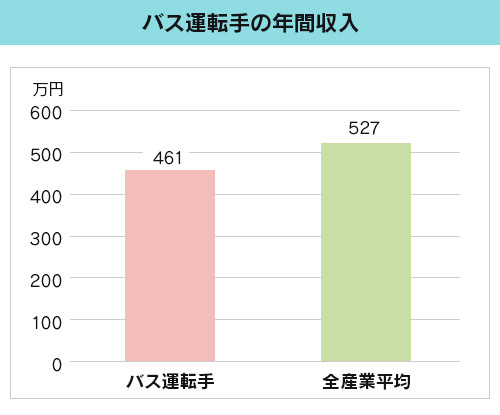
This is where the introduction of autonomous driving buses is gaining attention. The government has set a goal of realizing autonomous driving transportation services at 50 locations by FY2025, and fully spreading them to 100 locations by FY2027. From a technical standpoint, level 2 has already been implemented, and in some areas, level 4 autonomous driving is being implemented on limited driving routes. However, there are still challenges to overcome before autonomous driving buses can be fully adopted.
Definition of autonomous driving levels
There are different levels of autonomous driving, with level 0 being driving by a human and level 5 being fully autonomous driving under no conditions. Most of demonstration experiment currently being conducted in Japan are at level 2, and the first goal is to reach level 4, where all driving operations will be automated under specific conditions (specific routes, etc.).

Challenges for realizing autonomous driving buses ① - Infrastructure and environment development
One of the challenges facing the introduction of autonomous driving services is the wide range of preparations required. While vehicle-related technology tends to receive the most attention, simultaneously promoting environmental improvements, such as infrastructure and legal frameworks, is crucial for the safe and smooth operation of autonomous buses. Regarding roadside improvements along which autonomous buses will travel, for example, convex mirrors are currently installed in blind spots from vehicles. However, autonomous vehicles have difficulty obtaining information from these mirrors. Digitalizing and transmitting information about blind spots would further enhance the safety of autonomous vehicles. Other important considerations include the creation of dedicated lanes, the management and optimization of on-street parking and stopping, and the development of various communication systems. Autonomous operation is not a technology isolated to the vehicle itself; it must be integrated with the development of external environments, such as roads. Key issues to consider are how to achieve road-vehicle cooperation and a road environment that is easy to navigate, as well as who will bear the costs.
Challenges for realizing autonomous driving buses ② - Improving social acceptance
Building social consensus is also important. Data showing that autonomous driving leads to a reduction in traffic accidents has already been shown in countries such as the United States, where autonomous driving taxis are already in practical use. Even so, when an autonomous driving vehicle has an accident, it becomes big news, spreading public opinion that it is "dangerous after all," leading to the suspension of sales of autonomous driving vehicles and the interruption of autonomous driving services. Introducing autonomous driving buses will not lead to adoption unless residents are convinced and expect that they are "safe and convenient vehicles that I would definitely like to use." It is also necessary to establish legal systems and insurance and compensation systems in case of an accident, and improving this "social acceptability" is also a major challenge in introducing autonomous driving buses.
Furthermore, for operators working on autonomous driving bus businesses, whether they can achieve sufficient profitability is a major concern. If passenger numbers are repelled by "high fares" and the necessary number of passengers cannot be secured, or if the necessary subsidies are even higher than for regular buses, the future of the business is unclear. Bus operators will also need to make the business attractive by devising ways to secure a stable number of passengers and by collecting various data in conjunction with bus operations and using that data to develop new business opportunities. Furthermore, autonomous driving will change the role of the driver, potentially increasing opportunities for communication with passengers. It is also important that these new duties are acceptable to existing drivers. This also relates to "social acceptability," and fostering this is an essential initiative for the introduction of autonomous driving buses.
Steps towards realizing autonomous driving buses
Introducing self-driving buses requires extensive preparation. This requires not only addressing the driver shortage to maintain existing bus routes, but also considering how to maintain and develop the local public transportation network and formulating a public transportation plan based on a larger vision for regional revitalization. Within this, it is necessary to formulate a basic policy that defines how self-driving buses will be positioned, what their purpose will be, which routes they will be introduced on, and how they will be expanded. Without this, it will be impossible to gain support from residents or establish a cooperative system between related departments. Then, budgetary measures, including the use of subsidies, will be put in place, and specific introduction plans will be developed in consultation with related businesses and bus companies.
Once the route to be traveled is finalized, various data will be collected through demonstration experiment, which will then lead to demonstration operations at Level 2 and Level 4. Currently, in order to implement Level 4, it is necessary to obtain permission under the Road Transport Vehicle Act and the Road Traffic Act. With these permits and licenses in mind, it will be necessary to clear each required step one by one in consultation with the national government and police, starting from the demonstration stage on public roads.
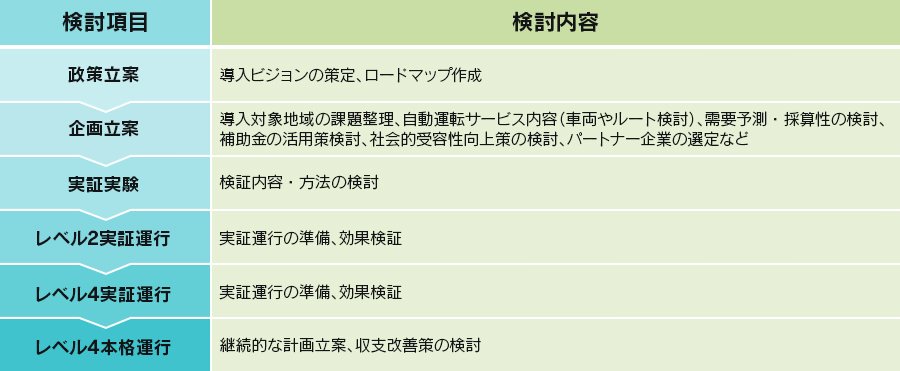
Some local governments are considering waiting a little longer to see how autonomous driving works, as it is still in the development stage, and considering introducing it once the technology has matured. However, it will be too late to start considering introducing it once the driver shortage actually becomes apparent. It is thought that at least three to five years will be required, including securing the budget, to move from considering introduction to demonstration experiment, demonstration operations, and finally commercial operation. A driver shortage is inevitable, so it is necessary to start taking measures early.
PACIFIC CONSULTANTS' Initiatives
PACIFIC CONSULTANTS believes that the development of autonomous driving systems is essential to solving public transportation issues in local areas, and since 2015 has been supporting the Cabinet Office, Ministry of Land, Infrastructure, Transport and Tourism, local governments, expressway companies, and private companies in various areas of policy planning for the introduction of autonomous driving, as well as planning and design, demonstration experiment, and demonstration operations.
For example, from November 2019 to the present, a Level 2 autonomous shuttle bus has been in commercial operation between Kashiwanoha Campus Station and the University of Tokyo Kashiwa Campus, and PACIFIC CONSULTANTS, as a member of the Kashiwa ITS Promotion Council, has supported the effort from implementation to commercial operation.
Sendai City is participating in the "Sendai City x Tohoku University Smart Frontier Council," which aims to implement cutting-edge services to solve social issues through PPP, and has planned and led the "Aobayama Green Excursion Project," which aims to improve mobility in the Aobayama area from 2023. In both cases, we are working to solve problems while involving relevant parties, with the aim of implementing Level 4 autonomous driving buses.
The study into the introduction of autonomous driving buses is aimed directly at solving the issue of a shortage of bus drivers, but the real goal is to stabilize local public transportation into the future and ensure comfortable and safe mobility for local residents. With autonomous driving buses as one option, we believe that our mission as consultants is to propose a new form of mobility society and provide various support to make it a reality.
PACIFIC CONSULTANTS' main work related to autonomous driving
PACIFIC CONSULTANTS has been involved in various initiatives with a wide range of clients, from central government ministries and agencies to local governments and private companies, and will continue to do our utmost to promote the social implementation of autonomous driving.
| Ordering Client | Business Content |
|---|---|
| Cabinet Office/NEDO | SIP (Autonomous Driving System: Phase 1, Phase 2) |
| Ministry of Land, Infrastructure, Transport and Tourism (Road Bureau, National Institute for Land and Infrastructure Management, Regional Development Bureaus, etc.) |
Autonomous driving demonstration in mountainous areas - Consideration of verification items for services, vehicle procurement, risk assessment, demonstration operation, etc. - Domestic and international trend research, policy planning support - Support for demonstration experiment of road-vehicle cooperative systems for autonomous driving |
| Ministry of Land, Infrastructure, Transport and Tourism (City Bureau, Logistics and Automobile Bureau) |
Support for policy formulation and demonstration evaluation for the introduction of autonomous driving technology to suburban housing complexes and main buses - Risk scenario research to ensure the safety of autonomous vehicles |
| Local Government | Considering the introduction of autonomous driving services - Selection of routes, schedules, and stops - Support for building a business promotion system - Drafting demonstration experiment plan (vehicle selection, operation details) - Implementation support (roadmap consideration, subsidy application consideration) - Formulation of autonomous driving service guidelines |
| Expressway Company | Traffic impact survey of autonomous driving vehicles, etc. |
| Private Sector | Creation of demonstration experiment plans, risk assessment, various permit applications, etc. |



